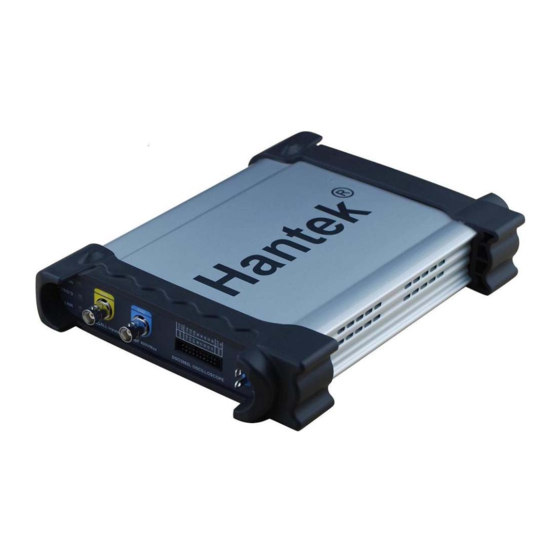
Table of Contents
Advertisement
Quick Links
Advertisement
Table of Contents

Summarization of Contents
Chapter 1 Getting Start
System Requirements
Specifies minimum and recommended computer configurations for software.
Install Software
Step-by-step guide for installing the oscilloscope software from a CD.
Install Driver
Instructions for connecting the device and installing the necessary USB driver.
General Features
Lists the main technical features and functionalities of the oscilloscope.
General Check
Guides on checking shipping, accessories, instrument, and probe compensation.
Function Check
Steps to perform a functional check to ensure the oscilloscope is operating correctly.
Self Calibration
Explains how to run the self-calibration routine for optimal measurement accuracy.
Accessories
Lists the standard accessories included with the oscilloscope for DSO3062L/AL.
Chapter 2 Operating Basics
The User's Interface
Explains the main menu, toolbar, panels, and status indicators of the software.
The Menu System
Details the main menu options like File, View, Setup, Display, Cursor, Measure.
The Vertical System
Explains how to set up the vertical parameters like channel, volts/div, coupling, and probe.
The Horizontal System
Details how to configure horizontal parameters like Time/DIV and format.
The Trigger System
Covers setting up trigger modes, sweep, source, and slope for edge and bus triggers.
Input Connectors
Describes the function of various input and output connectors on the device.
Chapter 3 Oscilloscope Functions
Setup the Oscilloscope
How to use Auto Setup, Save Setup, Load Setup, and Factory Setup options.
Set Vertical System
Guides on setting channel, volts/div, coupling, and probe attenuation.
Setup Horizontal System
How to change Time/Div and set the waveform display format (Y-T, X-Y).
Set Trigger System
How to configure trigger modes, sweep, source, and slope for edge triggers.
Save/Load
Instructions for saving and loading waveform data, setups, and images.
Record Utility Function
How to record and play back waveform data using the Record function.
Pass/Fail Utility Function
Explains how to set up and use the Pass/Fail test function with masks.
Factory Setup Utility Function
How to load default setups and restore factory settings.
Language Utility Function
How to change the user interface language.
Cursor Menu Measurement
How to use cursor types (Cross, Trace, Vertical, Horizontal) for measurements.
Measure Menu Measurement
Explains how to select measurement sources and types (Voltage, Time).
Zoom In/Out and Drag Waveforms
How to zoom in/out and pan/drag waveforms for detailed analysis.
Interpolation
Explains different interpolation modes for waveform smoothness.
Acquisition Modes
Describes acquisition modes: Normal, Average, and Peak Detect.
Print And Print Preview
How to print waveforms and use the print preview function.
Chapter 4 Application Example
Simple Measurement
Guide on acquiring signals and performing basic frequency and Vpp measurements.
Capturing a Single-Shot Signal
Steps for setting up triggers to capture single, non-repeating events.
The Application of the X-Y
How to use X-Y plot for comparing frequencies, amplitudes, and phases.
Taking Cursor Measurements
Guide on using cursors to measure frequency, time, and amplitude on waveforms.
Logic Analyzer
How to set up and use the Logic Analyzer, including display styles and formats.
Arbitrary Waveform Generator
How to generate various waveforms (Sine, Square, AM/FM, etc.) using the built-in generator.
Chapter 5 Appendix
Appendix A: Specifications
Detailed technical specifications for the oscilloscope's vertical, horizontal, and trigger systems.
Appendix B: Accessories
Lists and describes the accessories that come with the oscilloscope.












Need help?
Do you have a question about the DSO3062AL and is the answer not in the manual?
Questions and answers